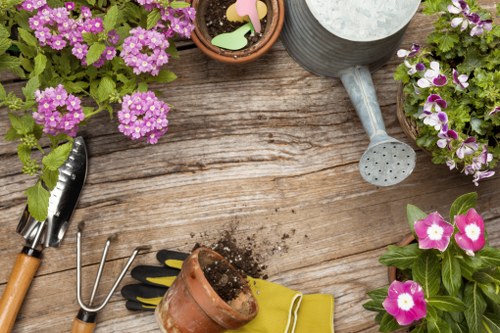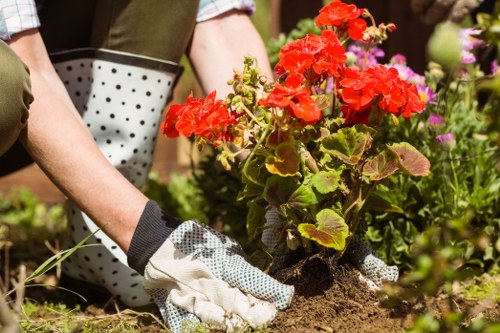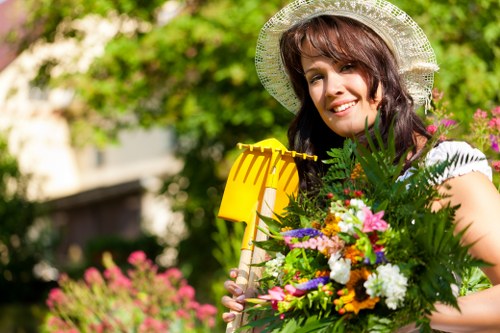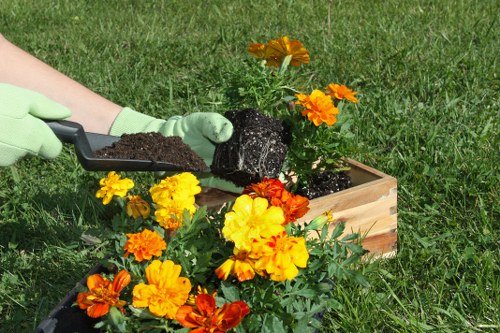Comprehensive Guide to Garden Maintenance in Staines

Maintaining a beautiful garden in Staines requires a combination of **dedicated care**, knowledge of the local climate, and the right tools. Whether you're a seasoned gardener or a beginner, understanding the key aspects of garden maintenance can transform your outdoor space into a vibrant and thriving oasis.
Staines, with its unique weather patterns and soil conditions, presents both opportunities and challenges for gardeners. By adopting best practices tailored to the area, you can ensure your garden remains healthy and picturesque throughout the year.
In this article, we'll explore essential garden maintenance tips, seasonal tasks, and the benefits of professional services to help you achieve and maintain a stunning garden in Staines.

Understanding Staines' Climate and Soil
Before diving into maintenance routines, it's crucial to understand the specific climate and soil conditions of Staines. This knowledge will guide your planting choices, watering schedules, and pest control measures.
Climate: Staines experiences a temperate maritime climate with mild winters and warm summers. Average temperatures range from 2°C in winter to 25°C in summer. This climate supports a wide variety of plants, but gardeners must be prepared for occasional frost and summer heatwaves.
Soil: The soil in Staines varies but is generally rich in nutrients. However, it's essential to test your soil's pH levels and nutrient content to ensure optimal plant growth. Most garden plants thrive in slightly acidic to neutral soil (pH 6-7).

Seasonal Garden Maintenance Tasks
Spring Maintenance
Spring is a critical time for garden maintenance. As the weather warms, it's the perfect opportunity to prepare your garden for the growing season.
Key Tasks:
- Cleaning: Remove any debris, dead leaves, and fallen branches from your garden beds.
- Pruning: Trim back overgrown shrubs and trees to encourage healthy growth.
- Soil Preparation: Add compost or manure to enrich the soil and improve its structure.
Starting your garden maintenance in spring sets the foundation for a lush and vibrant garden throughout the year.
Summer Maintenance
Summer brings the peak growing season, requiring consistent care to keep your plants thriving.
Watering: Ensure your garden receives adequate water, especially during heatwaves. Early morning watering is ideal to reduce evaporation.
Weeding: Regularly remove weeds to prevent them from competing with your plants for nutrients and water.

Essential Tools for Garden Maintenance
Having the right tools can make garden maintenance more efficient and enjoyable. Here are some essentials every gardener in Staines should consider:
- Pruners: For trimming and shaping plants.
- Garden Fork: Useful for aerating soil and removing weeds.
- Watering Can or Hose: Essential for keeping plants hydrated.
- Gloves: Protect your hands from thorns, dirt, and pests.
- Wheelbarrow: Convenient for transporting soil, compost, and plants.
Investing in quality tools not only improves the efficiency of your garden maintenance but also enhances the overall health of your garden.
Soil Health and Fertilization
Maintaining healthy soil is fundamental to successful gardening. Healthy soil provides essential nutrients, supports beneficial microorganisms, and ensures proper drainage.
Fertilization: Use organic fertilizers, such as compost or well-rotted manure, to replenish soil nutrients. Avoid over-fertilizing, which can lead to excessive foliage growth at the expense of flowers and fruit.
Soil Testing: Regularly test your soil to monitor pH levels and nutrient content. Adjustments can be made based on test results to create optimal growing conditions.

Pest and Disease Management
Pests and diseases can significantly impact the health and appearance of your garden. Implementing proactive measures can help prevent and manage these issues effectively.
Identifying Common Pests
- Aphids: Small insects that suck sap from plants, causing wilting and distorted growth.
- Slugs and Snails: Mollusks that feed on leaves and stems, particularly in damp conditions.
- Spider Mites: Tiny arachnids that cause stippling and discoloration of leaves.
Natural Pest Control Methods
Opt for environmentally friendly pest control methods to protect your garden without harming beneficial insects.
- Beneficial Insects: Introduce ladybugs and lacewings, which prey on common garden pests.
- Neem Oil: A natural pesticide effective against a variety of insects.
- Barriers: Use copper tape or diatomaceous earth to deter slugs and snails.
Implementing these methods helps maintain a balanced ecosystem in your garden, promoting healthy plant growth.
Managing Plant Diseases
Fungal and bacterial diseases can devastate gardens if not addressed promptly.
Prevention: Ensure proper spacing between plants to improve air circulation and reduce humidity, which can prevent fungal growth.
Early Detection: Regularly inspect your plants for signs of disease, such as discoloration, spots, or wilting. Early intervention can prevent the spread of disease.

Pruning and Trimming Techniques
Proper pruning and trimming are essential for maintaining the shape, health, and productivity of your plants.
When to Prune
Different plants have specific pruning schedules. Generally, late winter or early spring is ideal for most shrubs and trees, while summer pruning is suitable for flowering plants.
Pruning Methods
- Thinning: Remove entire branches to increase light penetration and air circulation.
- Heading: Cut back the tips of branches to encourage bushier growth.
- Deadheading: Remove spent flowers to promote new blooms and prevent seed formation.
Using the right pruning techniques enhances the overall appearance and health of your garden.
Tools and Safety
Always use sharp, clean tools to make precise cuts and reduce the risk of disease transmission.
Safety Tips:
- Wear appropriate protective gear, such as gloves and safety glasses.
- Be cautious when using ladders or elevated platforms.
- Dispose of pruned material properly to prevent the spread of pests and diseases.

Mulching for a Healthy Garden
Mulching is a simple yet effective practice that offers numerous benefits for your garden.
Benefits of Mulching
- Moisture Retention: Helps keep the soil moist by reducing evaporation.
- Weed Suppression: Prevents weed seeds from germinating by blocking sunlight.
- Temperature Regulation: Insulates the soil, keeping it cooler in summer and warmer in winter.
- Soil Improvement: Organic mulches break down over time, adding nutrients to the soil.
Types of Mulch
Choose the right type of mulch based on your garden's needs and aesthetic preferences.
- Organic Mulch: Includes materials like bark, straw, and compost. These mulches enrich the soil as they decompose.
- Inorganic Mulch: Comprises materials like gravel, rocks, and rubber. They are long-lasting and require less frequent replacement.
Selecting the appropriate mulch enhances both the functionality and visual appeal of your garden.
Proper Mulching Techniques
To maximize the benefits of mulching, follow these best practices:
- Depth: Apply mulch to a depth of 2-3 inches to ensure effectiveness.
- Distance from Plants: Keep mulch a few inches away from plant stems and trunks to prevent rot and disease.
- Avoid Over-Mulching: Excessive mulch can suffocate plant roots and inhibit water penetration.

Lawn Care and Maintenance
A well-maintained lawn enhances the overall beauty of your garden and provides a serene space for relaxation and recreation.
Mowing Tips
Proper mowing techniques promote a healthy and attractive lawn.
- Height: Set your mower blades to the appropriate height for your grass type, typically 2.5-3.5 inches.
- Frequency: Mow regularly, cutting no more than one-third of the grass height at a time.
- Sharp Blades: Keep mower blades sharp to ensure clean cuts and reduce stress on the grass.
Watering Practices
Deep and infrequent watering encourages strong root growth and drought resistance.
Best Time to Water: Early morning is the optimal time to water your lawn, minimizing evaporation and reducing the risk of fungal growth.
Fertilization and Aeration
Regular fertilization provides essential nutrients for lush growth.
Aeration helps alleviate soil compaction, allowing better water and nutrient penetration.
- Fertilize: Apply a balanced fertilizer in spring and autumn.
- Aerate: Perform aeration annually to maintain soil health.

Plant Selection and Placement
Choosing the right plants and placing them strategically can dramatically improve the aesthetics and sustainability of your garden.
Selecting Suitable Plants
Consider the following factors when selecting plants for your garden in Staines:
- Climate Compatibility: Choose plants that thrive in Staines' temperate maritime climate.
- Soil Requirements: Ensure the plants you select match your soil's pH and drainage characteristics.
- Sunlight Exposure: Assess the amount of sunlight different areas of your garden receive and select plants accordingly.
Strategic Plant Placement
Proper placement can enhance plant health and garden beauty.
Height Considerations: Place taller plants at the back or center of garden beds, with shorter plants in front.
Companion Planting: Plant compatible species together to promote mutual growth and deter pests.
Thoughtful plant selection and placement create a harmonious and visually appealing garden environment.
Creating Focal Points
Incorporate focal points to draw attention and add character to your garden.
- Ornaments: Use garden statues, birdbaths, or sundials as central features.
- Flower Beds: Design vibrant flower beds with a mix of colors and textures.
- Water Features: Install fountains or ponds to add a soothing element to your garden.

Benefits of Professional Garden Maintenance
While DIY garden maintenance can be rewarding, hiring professional services offers several advantages, especially for extensive gardens or those requiring specialized care.
Expertise and Knowledge
Professional gardeners possess the expertise to handle complex maintenance tasks, diagnose plant issues, and implement effective solutions.
Time and Convenience
Outsourcing garden maintenance frees up your time, allowing you to enjoy your garden without the stress of upkeep.
Customized Maintenance Plans
Professionals can create tailored maintenance plans that meet the specific needs of your garden, ensuring optimal health and beauty.
Hiring a professional garden maintenance service in Staines ensures that your garden receives the best care, allowing you to reap the benefits of a stunning and well-maintained outdoor space.
Conclusion
Maintaining a garden in Staines is a fulfilling endeavor that requires **dedication**, knowledge, and the right practices. By understanding the local climate and soil, adhering to seasonal maintenance tasks, using proper tools, and considering professional services, you can achieve a vibrant and healthy garden.
Whether you're cultivating a small backyard garden or managing a larger landscape, the principles outlined in this guide will help you create and sustain a beautiful garden that thrives year-round.
Ready to transform your garden? Contact us today to book your garden maintenance service in Staines and enjoy a lush, well-maintained outdoor space.